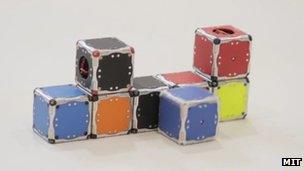'Terminator' self-assembling cube robots revealed by MIT
- Published

The research has been carried out by MIT's Computer Science and Artificial Intelligence Laboratory
Cube-shaped robots that can flip, jump and assemble themselves into different shapes by scientists at the Massachusetts Institute of Technology (MIT).
The small robots, known as M-Blocks, have no external parts but can move using an internal flywheel mechanism.
They stick together using magnets.
The scientists envisage miniaturised "swarmbot" versions self-assembling like the "liquid steel" androids in the Terminator films.
More realistically, the researchers at MIT's Computer Science and Artificial Intelligence Laboratory (CSAIL), believe armies of such cubes could be used for making temporary repairs to bridges or buildings, or as self-assembly, re-configurable scaffolding.
Modular robots have the advantage of being able to adapt to whatever task or terrain is presented to them.
The modular M-Block robot with its innards and flywheel exposed
John Romanishin, one of the research scientists at CSAIL leading the project, said: "We want hundreds of cubes, scattered randomly across the floor, to be able to identify each other, coalesce, and autonomously transform into a chair, or a ladder, or a desk, on demand."
The M-Blocks are currently controlled by computer instructions sent over wireless radio, but in future the researchers hope algorithms can be loaded on the blocks directly, making them entirely autonomous and capable of adapting to different environments.
Blocks equipped with sensors and cameras would be able to work out how to accomplish specific tasks in combat or emergency situations, the scientists hope.
- Published27 September 2013
- Published24 September 2013